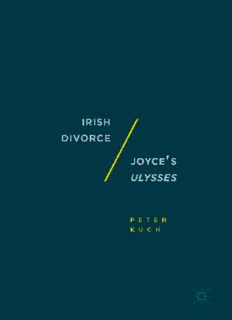
Irish Divorce / Joyce's Ulysses PDF
Preview Irish Divorce / Joyce's Ulysses
’ Irish Divorce/Joyce s Ulysses Irish Divorce/ ’ Joyce s Ulysses Peter Kuch PeterKuch UniversityofOtago Dunedin,NewZealand ISBN978-1-349-95187-1 ISBN978-1-137-57186-1(eBook) DOI10.1057/978-1-137-57186-1 LibraryofCongressControlNumber:2017939123 ©TheEditor(s)(ifapplicable)andTheAuthor(s)2017 This work is subject to copyright. All rights are solely and exclusively licensed by the Publisher,whetherthewholeorpartofthematerialisconcerned,specificallytherightsof translation, reprinting, reuse of illustrations, recitation, broadcasting, reproduction on microfilms or in any other physical way, and transmission or information storage and retrieval,electronicadaptation,computersoftware,orbysimilarordissimilarmethodology nowknownorhereafterdeveloped. Theuseofgeneraldescriptivenames,registerednames,trademarks,servicemarks,etc.inthis publicationdoesnotimply,evenintheabsenceofaspecificstatement,thatsuchnamesare exemptfromtherelevantprotectivelawsandregulationsandthereforefreeforgeneraluse. Thepublisher,theauthorsandtheeditorsaresafetoassumethattheadviceandinformation in this book are believed to be true and accurate at the date of publication. Neither the publishernortheauthorsortheeditorsgiveawarranty,expressorimplied,withrespectto thematerialcontainedhereinorforanyerrorsoromissionsthatmayhavebeenmade.The publisherremainsneutralwithregardtojurisdictionalclaimsinpublishedmapsandinstitu- tionalaffiliations. Printedonacid-freepaper ThisPalgraveMacmillanimprintispublishedbySpringerNature TheregisteredcompanyisNatureAmericaInc. Theregisteredcompanyaddressis:1NewYorkPlaza,NewYork,NY10004,U.S.A. “Ignorantiajurisnon excusat.” “Every manispresumed toknow the law.” For Declan P REFACE ThisbookoffersarevisionistreadingofJoyce’sUlyssesbyexaminingIrish attitudes to marriage and the wide-ranging English, Irish, American, and French debates about divorce that were conducted between 1904, when Joyce’snovelofadulteryisset,and1922,whenitwaspublished.Itdraws attentiontoanIrishpracticethat,eventhoughitwasknownatthe time, hassincedisappearedfromthecritical,historical,andlegalliteratureabout Ulyssesandabout Irishdivorce. ItiswellknownthatJoycewasanavidreaderofnewspapers,themost commonandpopular sourceof information about divorce.1 1Garry Leonard, Advertising and Commodity Culture in Joyce (Gainesville: University Press of Florida, 1998); Barbara Leckie, Culture and Adultery: The Novel, the Newspaper and the Law 1857–1914 (Philadelphia: University of Pennsylvania Press, 1999); Declan Kiberd, “Ulysses, Newspapers and Modernism,” in Irish Classics (London: Granta Books, 2000), 463–81; Barbara Leckie, “The Simple Case of Adultery,” JamesJoyce Quarterly 40, no. 4 (2003): 729–52; Katherine Mullin, James Joyce, Sexuality and Social Purity (Cambridge: Cambridge University Press, 2003); James A. Reppke, “Journalist Joyce: A Portrait,” James Joyce Quarterly 45, nos. 3–4 (2008): 459–68; R. Brandon Kershner, The Culture of Joyce’s “Ulysses” (New York: Palgrave Macmillan, 2010); Jennifer Wicke, “Modernity Must Advertise: Aura, Desire, and Decolonization in Joyce,” James Joyce Quarterly 50, nos. 1–2 (2012–2013): 203–21; Margot Backus, Scandal Work: James Joyce, the New Journalism, and the Home Rule Newspaper Wars (Notre Dame, IN: University of Notre Dame Press,2013). ix x PREFACE It is also well known that Joyce was fascinated by accounts of divorce hearingsthatappearedalmostdailyintheIrishpressfromDilke(1886)to Parnell(1890),totheestablishmentoftheFreeStatein1922,2andwith increasingfrequencyintheEnglishpressbetweenthe1857ActtoAmend theLawRelatingtoDivorceandMatrimonialCausesinEnglandandthe 1926JudicialProceedings(RegulationofReports)Act,whichenforceda measure ofrestraint.3 Whathasnotbeenrealizedisthatthedualtime-schemeofUlysses,setin 1904butwrittenwhileIrelandwasviolentlyrenegotiatingitsrelationship toEmpire,providedJoycewithastancefromwhichtointerrogatewaysin whichsometimesrivalandsometimescollusiveImperialandEcclesiastical hegemonies forged the Edwardian Irish social imaginary. What unwit- tingly resulted from this complex, shifting contestation for control of the IrishmindwastheprovisionofaspacethatgaveIrishlitigants,from1858 to1922,limitedaccesstotheProbate,DivorceandAdmiraltyDivisionof the King’s Bench,whichsat only in London. Consequently, no one has investigated the extent to which Bloom’s “Divorce, not now” and Molly’s “suppose I divorced him” are realistic possibilities rather than passing fantasies (17.2202; 18.846), and no one hasinvestigatedtheextenttowhichBloom’sandMolly’sthoughtsabout divorce,thoughtsthatfindexpressionintheearlyhoursof17June1904, arise fromandcolorall eighteen episodesof Ulysses. IrishDivorce/Joyce’s“Ulysses”demonstratesthatdivorcewasarealis- ticoptionfortheBlooms—whetherwhim,fantasy,wish,orconviction— following Molly’s affair with Hugh Boylan. It does so, in an attempt to avoid presentism,4 by cross-referencing the fifty-fourth edition of Every Man’s Own Lawyer (1919) Joyce is known to have possessed with contemporary Ecclesiastical and Parliamentary debates, public 2DiarmaidFerriter,OccasionsofSin:SexandSocietyinModernIreland(London: ProfileBooks,2009),105–6;PeterMartin,CensorshipintheTwoIrelands,1922– 1939(Dublin:IrishAcademicPress,2006),32. 3See Gail Savage, “Erotic Stories and Public Decency: Newspaper Reporting of DivorceProceedingsinEngland,”TheHistoricalJournal41,no.2(1998):511– 28. The Judicial Proceedings Act can be accessed at http://bailii.austlii.edu.au/ uk/legis/num_act/1926/ukpga_19260061_en.html. 4MartinJay,“HistoricalExplanationandtheEvent:ReflectionsontheLimitsof Contextualization,”NewLiteraryHistory42(2011):557–71. PREFACE xi enquiries, relevant legal texts, and the 1912 Royal Commission on divorce. It also cross-references 1,500 divorce cases reported in various detail in the Irish and English newspapers that Joyce read whenever he couldgetaccesstocopieswithsome850DivorceCourtMinutesdepos- itedintheNationalArchivesinLondon,particularlythosethatrelateto Irish pleas of the period. ThebookfurtherengageswitharichveinofJoycescholarshiprevealed by Richard Brown’s James Joyce and Sexuality (1985), Joseph Valente’s James Joyce and the Problem of Justice: Negotiating Sexual and Colonial Difference (1988), Vicki Mahaffey’s Reauthorizing Joyce (1988), Marian Eide’s Ethical Joyce (2002), Andrew Gibson’s Joyce’s Revenge (2002), Katherine Mullin’s James Joyce, Sexuality and Social Purity (2003), and LucaCrispi’sJoyce’sCreativeProcessandtheConstructionofCharactersin “Ulysses”:Becoming theBlooms (2015). It concludes that the Blooms’ commitment to one another is more provisional than has previously been realized and that the engorged full stop at the end of “Ithaca” and Molly’s final “Yes.” represent temporary accommodationsratherthanforgiveness,qualifiedcommitment,orsepara- tion. And itmaps several ofthe pathsbywhich Bloomand Mollybecome interpellatedbytheheuristicandlegaldiscoursesassociatedwithdivorce. Irish Divorce / Joyce’s “Ulysses” is not a book about Joyce’s attitude or attitudestodivorceoraboutdivorceinJoyce’scorpus,asrelevantassome critics believe Exiles and Giacomo Joyce are to understanding Bloom’s situation. Nor is it a book about divorce in Finnegans Wake, or what might happen tothe Blooms after16June1904. Instead,itproposesthatknownIrishaccesstotheProbate,Divorceand AdmiraltyDivisionoftheKing’sBench,theprominencegiventodivorce in Edwardian print culture, and the extent to which divorce was being expunged from the Irish social imaginary even while Ulysses was being writtenchallengedJoycetoreconfigurehisdomesticodysseyasanovelof adultery by interrogating ways in which competing narratives, multiple voices, and self-reflexivity were played off against one another within a patriarchal legal discourse about divorce that had been and was being widely discussed in England, Ireland, and France (though not Italy5) throughoutthe first two decadesof the twentiethcentury. 5MarkSeymour,DebatingDivorceinItaly:MarriageandtheMakingofModern Italians(London:PalgraveMacmillan,2006). xii PREFACE As he was writing Ulysses, Joyce came to realize that Irish recourse to theEnglishjurisdictionfordecreesabsoluteprovidedhimwithaspaceto dramatizeonewayofsubvertingthepowerof“theimperialBritishstate” (utilizing the state’s definition of “domicile” against itself) and the “holy Roman catholic and apostolic church” (obtaining a decree absolute) even while it drew attention to what was actually happening in Edwardian Ireland(the “Ireland” of“oddjobs”) (1.641–44). Finally, Irish Divorce / Joyce’s “Ulysses” raises the provocative and timely questions:whywasIrishrecoursetotheEnglishdivorcecourtexpungedfrom Joycecriticism,fromIrishhistory,andfromtheIrishsocialimaginarybetween 1922and1986,andwhatdoesthistellusaboutthestateandthenation?
Description: